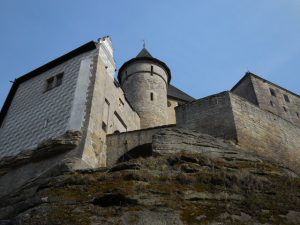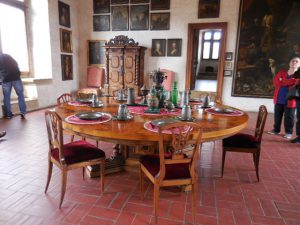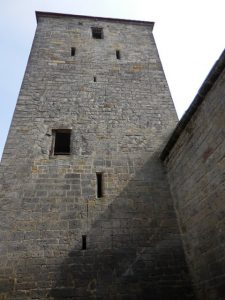Kost and Trosky Castles
By Tracy A. Burns
A jewel of the Bohemian Paradise
 Gothic Kost Castle boasts a scenic location in the Bohemian Paradise region of the country. Back in the 14th century, when it was first mentioned in writing, Kost was a wooden fortress. Benes from Vartemberk had it built and used the Latin name Benessuis de Costa on official documents. Czechs mispronounced Costa as Kost, which means “bone” in Czech.
Gothic Kost Castle boasts a scenic location in the Bohemian Paradise region of the country. Back in the 14th century, when it was first mentioned in writing, Kost was a wooden fortress. Benes from Vartemberk had it built and used the Latin name Benessuis de Costa on official documents. Czechs mispronounced Costa as Kost, which means “bone” in Czech.
From the Vartemberks through the 17th century
Petr from Vartemberk transformed the wooden fortress into a stone structure and constructed the castle’s Vartemberk Palace during the 14th century. The Biberstejn Palace of the castle dates from the 16th century. During the Thirty Years’ War, in May of 1635, the Czech soldiers stationed there got drunk and accidently burned down the castle, which was not repaired until the end of the 17th century. A brewery was on the premises from 1576 until 1945.
Other owners of the castle
Kost Castle was never conquered. It is located in a strategic position because it is hidden among three valleys and not visible from a distance. The castle has had many owners, including members of the Selemberk, Biberstejn, Lobkowitz and Cernin families. The last owner, Anna Maria del Borgo Netolitz, lost possession of the castle when it was nationalized in 1948. Kost first opened its doors to visitors in 1950. It is no longer state-owned. During 1993 the castle came into the hands of Anna Maria del Borgo Netolitz’s husband, Norbert Kinsky.
Golden Hall
 The most beautiful space in the castle is Golden Hall. Many valuable paintings, including portraits of the Kinsky clan, can be seen here. A private chapel with an intriguing Madonna statue is not to be missed. The Virgin Mary holds Jesus on a sort of ball, so that He appears to be standing.
The most beautiful space in the castle is Golden Hall. Many valuable paintings, including portraits of the Kinsky clan, can be seen here. A private chapel with an intriguing Madonna statue is not to be missed. The Virgin Mary holds Jesus on a sort of ball, so that He appears to be standing.
The black kitchen, White Tower and Chapel of Saint Anne
 A black kitchen dates from the 17th century. The space is called a “black kitchen” because food was cooked directly on an open fire, which turned the walls black. The White Tower contains five floors and is 32 meters high. Along with an exhibition of historical weapons, in the armory visitors can see two 15th century stained glass windows that were originally in the Chapel of Saint Anne but moved after the holy place was robbed at the beginning of the 20th century. The Chapel of Saint Anne dates from the 15th century, and while the furnishings are not original, they are sure to amaze.
A black kitchen dates from the 17th century. The space is called a “black kitchen” because food was cooked directly on an open fire, which turned the walls black. The White Tower contains five floors and is 32 meters high. Along with an exhibition of historical weapons, in the armory visitors can see two 15th century stained glass windows that were originally in the Chapel of Saint Anne but moved after the holy place was robbed at the beginning of the 20th century. The Chapel of Saint Anne dates from the 15th century, and while the furnishings are not original, they are sure to amaze.
The exhibition of torture instruments
The castle also includes an exhibition of torture instruments in spaces that used to be cellars where food and grains where kept. Visitors see artifacts such as 18th century Spanish boots, a 17th century execution sword and an iron humiliation mask worn in the 17th and 18th centuries. A copy of a guillotine that was even used during the First Czechoslovak Republic and the Nazi Protectorate is on display, too.
To be a witch or not to be a witch
At the torture exhibition the guide will explain to you that for women who were thought to be witches, it was a no-win situation. The accused were locked in a cage and then immersed in water for about 10 minutes. If they died while in the water, they were declared innocent and given a decent burial. If they lived through the ordeal, they were said to be guilty and burnt at the stake.
Trosky Castle: another highlight in the area
There is much more to see in the Bohemian Paradise area. Take the romantic ruin of Trosky Castle, for example. Trosky was built by Cenek from Vartemberk during the 14th century. According to one legend, a later owner, Ota the Younger of Trosk buried a treasure in the castle behind a large rock that no one has been able to move.
Panna and Baba Towers
The castle was partially burned down during the Hussite Wars. It became a total ruin during the Thirty Years’ War when it was razed by Imperial troops. The castle features two towers, Panna (The Virgin), which rises 57 meters above ground and Baba (The Old Woman), which is 47 meters high. On Baba Tower there is an observation deck. During the 19th century, there were plans to build a staircase to Panna tower, but the construction was not finished.
Other attractions in the Bohemian Paradise
The Bohemian Paradise offers visitors a wealth of opportunities for exploring the beauty of the Czech Republic. Hruby Rohozec Chateau and Valdstejn Castle are two other places worth touring. Gothic Kost Castle and romantic Trosky Castle are definitely two highlights of the region.



